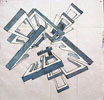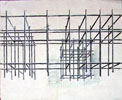zandpoortvest 10
be 2800 mechelen
t +32 15 336 336
m (b) +32 478 811 441
m (d) +32 475 477 478
Karel Breugelmans: text & publications
Monografie Karel Breugelmans 'Constructies 1990-2015, 2015
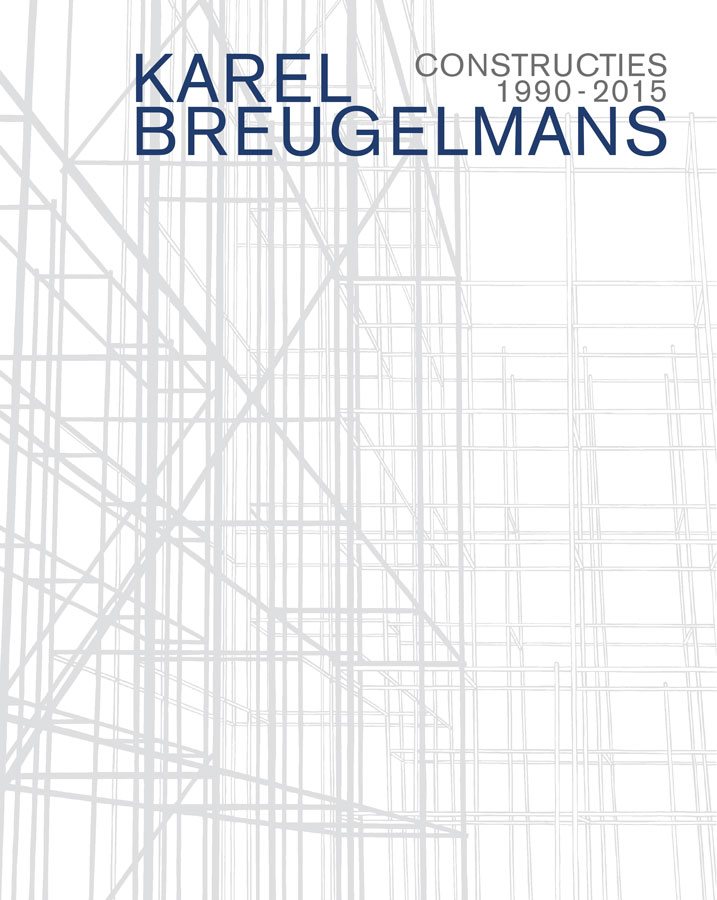
Bart de Baere: Foreword
It's good to be given the chance to write a foreword for this book on Karel Breugelmans, knowing that effective writers will subsequently guide readers towards the value of this oeuvre in words. Words are never more than a signpost in art, one that refers us back to the work and thereby designates it as a place.
The essay by Luk Lambrecht has already been written as I write this foreword, and it is a piece in which, on the basis of his observations on this oeuvre, this viewer of art and thinker on art establishes four concepts which are themselves generous references back to the work; stay with the work, it is a worthwhile place.
A month ago I heard that Peter Lang of Berlin had died suddenly, and that this book thereby lost a voice it should have included and which was of particular value to Karel Breugelmans. It is a consolation to hear that Christophe Tannert, who has guided so many artists and brought them to our attention, was prepared to write a piece as a continuation of the commitment of his friend and colleague.
In this foreword I do not want to repeat in a diluted form the clarification offered by these writers, or to start off on a new track and add to their yet another point of view, even if more concise and less well-founded, as is often the case in forewords. Nor do I want to provide the roll of drums that heralds their essays. Karel Breugelmans' work is frugal, lean and sincere.
So let me just tell you how I first encountered it. It was at the time when it first appeared on the somewhat broader scene that is called 'the art world'.
In 1997, Wivina De Meester, as Flemish Minister of Finance and Budgets, was responsible for government buildings. She recalled an act on integrated art that the Flemish Parliament had once unanimously passed and which had subsequently remained a dead letter. She asked the property developer who was constructing the Graaf de Ferraris and Hendrik Conscience buildings for the Flemish Community whether she could introduce the percentage of art commissions that had been legislated for. Permission was given. The whole policy concerning art in public buildings ensued from that point, but the first step was a simple competition with a few lines of rules and a mass of entries.
We, the jury, could have made it easy for ourselves, since there were no criteria in the rules, by simply selecting the usual suspects, but that would not have been a good move. There was one entry whose simple, direct argumentation I can still remember clearly. The candidate worked in the building sector and he painted architectural constructions stripped down to the minimum. He wrote that the Graaf de Ferraris building would be housing the Department of the Environment and Infrastructure, so his artistic reflections would be in exactly the right place there.
They were small, square canvases showing concrete constructions in perspective, in shades of grey, simplified so much that they became almost abstract forms and lines. They remained constructions. The paint had been applied with a slow, humble focus that made them into paintings, paintings that might have hung not far from those of Dan Van Severen or Raoul De Keyser. These works are now owned by the Flemish Community. They are administered by its General and Technical Services Department, or in plain language 'the Flemish government's buildings department'.
They were painted by Karel Breugelmans.
Chrstoph Tannert: Hypnotically linked structural components, 2014
A wide range of attitudes is possible when coming face to face with the work of Karel Breugelmans. These artefacts, which are almost hypnotically connected, help the viewer explore time and space and enable him to shift from a particular fixed position. In exhibitions, Breugelmans' constructive and deconstructive works, which represent potential realities, are naturally installed in a specific way, but strictly speaking this goes against the artist's intention.
So it is advisable for the viewer to look at the artefacts from various angles. Breugelmans turns things upside down. It is only by mutual agreement that we know what is top or bottom, what points upward or downward. In this regard, such artist-utopians as Alexander Rodchenko, El Lissitsky and László Moholy-Nagy preceded Breugelmans in the first half of the 20th century. Think of Lissitsky's 'fourth dimension' and his 'proun' concept, his idea of formal control as a decision to hold sway over space, his new world, which would be able to create itself out of a simple set of universally applicable basic elements, his idea of overcoming the individual and the national – out of all this arises a vision which, we hope, since the end of the ideologies and the fall of the Iron Curtain at the end of the 1980s, is no longer able to be perverted by authoritarian systems.
Breugelmans shows us how the make-up of the world without the propaganda declarations of totalitarian strong-men could become a reality. Breugelmans' forms follow the more or less accidental team action of self-organisation rather than the principle of the party leader. Art and society accommodated the notion of a revolutionary (i.e. working for the government) socialist avant-garde for long enough.
Breugelmans argues for complex networks, movement, a change of viewpoint and room for movement. His works mark out a new, dynamic course. They urge us in the direction of dynamic thinking, which – while taking account of environment and infrastructure in the new 'urban age' that urban planners see dawning – can also definitely be politically interpreted.
In drawings, paintings and objects, Breugelmans is not concerned with one single big idea, but with the parallel existence of atmospheres, a parallelism and simultaneity of ideas which possibly consider the 'mixed city' (in which housing, work and leisure take place together) as the most obvious solution and force through multiform plans for a variety of forms of urban fabric.
It is not only the 'Città Ideale', but also the 'Charter of Athens', largely formulated by Le Corbusier, which in Europe are no longer the model for the very large-scale master-plan, which probably only Chinese authorities in that country's 'boom towns' are able to implement against the will of their citizens.
In this connection, the question of whether verticality is reactionary or progressive is also of interest. There is for the moment no lack of revolutionary plans. The predilection for skyscrapers is undiminished.
The 'Sky City' proposed by the Chinese entrepreneur Zhang Yue (1), for example, is conceived as a skyscraper with 202 storeys. One day 30,000 people will live in it. If everything goes according to the audacious plans of the investors and architects, this 838 m. tower would be built in the city of Changsa in the Southern Chinese province of Hunan. Traffic jams and pollution would no longer exist there.
The building would incorporate nurseries, schools, hospitals and rest homes, offices, big shopping centres, hotels and cinemas. Plus swimming pools and sports fields for basketball and tennis, even vertically constructed organic farms. Pedestrians could walk from the 1st to the 180th storey up a 10-kilometre spiral street. There would no longer be any car traffic. The idea of verticalism would save on streets and car parks, energy and traditional traffic areas.
When I saw Breugelmans' coordinates, scaffolding, grids and lattices and his Construction XXII (2011), I was instantly reminded of the 'Sky City'. But that structure has so far not been built.
However, Breugelmans connects together his structural components to form an ornamental groove, which has the potential to surge infinitely outward.
Each detail effortlessly moves from lyrical simplicity to rhythmic complexity and ranges from playful in a minimalist manner to large-scale compression in the nature of a soundtrack.
(1) Xifan Yang: 'Häuslebauer im Höhenrausch', in Die Zeit, 5/2013
Luk Lambrecht: Propositions concerning the oeuvre of Karel Breugelmans, 2014
Findings
It is notable that a coherent oeuvre arises out of the professional activity, not associated with the art world, of an artist in a normal job who has thereby safeguarded, preserved and extended his artistic autonomy.
Reconciling the hard, concrete labour of a building contractor with the free association of dreams that head in the direction of both art and utopia is more than just a relevant intermediate position, and in Karel Breugelmans' case it yields art that steers a course in the formal waters of modernism.
The 'constructions' that Breugelmans devises and makes are to be seen as a single large building site, a massive structural skeleton. They leave the freedom to finish the work entirely in the hands of the viewer's imagination. Here lies the strength, the poetry and the long life of a work of art.
Karel Breugelmans does sculptures, installations, drawings and paintings as a single artistic suite/output that puts the accent on the image and not on any story accompanying or about the finished – or rather the delivered – work of art.
Breugelmans' oeuvre is consistent and unique in our part of the world because in terms of form it has few if any contemporary references. His gentle constructivism is disarming not only because of its passionate craftsmanship, but also by its application of a range of cool colours, whereby this work is in part piloted towards the times when art still contained an element of utopia and the artist subscribed to a societal project that aspired to improve everyone's fortune and happiness.
Breugelmans' constructions leave a distant echo of a time when the 'great narratives' kept the engine of social discourse turning, inspired by the desire to keep cohabitation viable and just.
As a consequence, they are not dry fixations, but enticing blueprints that are able to set the 'constructive' imagination in motion. They are grids that are the motifs for every possible concept in which art adopts the idea of reality in a quest for the future.
Visual language
The 'drawn' paintings make it clear how masterfully Karel Breugelmans is able to apply and adjust the knowledge of his profession perfectly in a logical visual idiom reminiscent of a technical drawing that reinvents the notion of 'construction' by way of neatly devised compositions. In the mind, the images of self-supporting 'scaffolding' become immeasurable, even to the extent that the thought of them can be taken 'further' in an urban sense.
In each case, this work conceals a 'different' place, a city – una Città Ideale – whereby the scaffolding/the skeleton of the constructions make allusions to the fact that art is not a metaphor but an open vehicle which, wherever and whenever, can provide the occasion to be 'filled in' against the 'then' prevailing cultural, ideological and political-economic backgrounds. In this regard, it is more than remarkable that man remains out of the picture in Breugelmans' oeuvre, analogously to, for example, the 'old' painting 'Città Ideale' (Galleria Nazionale delle Marche, Urbino) and the photos of cities from the late 1980s by the German photographer Thomas Struth (Geldern, 1954).
Utopia
This takes us to the notion of 'Utopia', to images that avoid everyday reality and which invite one to dream and to use the scaffolding literally to work, in profound thought, on 'something' whose existence is still outside of ourselves.
The grid is Breugelmans' main visual principle; the grid as the perfect modernist canon for the introduction of order into thinking and looking, and which forms the basis of perspective and all forms and offshoots of modernist art. This is an art that does not easily and safely settle into the domain of imitation, but which, on the contrary, provides frameworks by which to place art 'in' a world by means of the abstract language of lines, planes, volumes and colour. 'A' world that can be considered like an agora for the projection of the private feelings and thoughts of those who want to actively experience and use the work of art. In this regard there is probably some sense in mentioning the work of the utopian architect Yona Friedman (Budapest, 1923), who, without himself ever building, but by means of a form of model-based thinking on architecture and urban planning, succeeded in reflecting fundamentally on how the world and humanity can survive. Yona Friedman makes models, but also fantastic installations such as the one in the Butcher's Hall in Middelburg (2012), where, using hardly more than one component (metal), he produced an 'idea' of space that gave mental and physical access to another way of dealing with organised space. In Karel Breugelmans' work too, one finds an echo of a 'forward-looking' reflection, though his work does not follow in the wake of any visible notion of improving the world. Breugelmans' art at the most suggests a shell of and for the 'future'. The transparency of his hanging sculptures makes them like cages because they evoke both openness and closedness. They are grids in an environment, spatial drawings reminiscent of the work of the American artist Agnes Martin (Canada, 1912-New Mexico, 2004) and even the 'Cage Piece' by Bruce Nauman (USA, 1941).
Breugelmans' art establishes itself soundlessly amongst that art in which the politically explicit was part of its production. In Karel Breugelmans' art production, the intentions remain stuck in the implicit.
Model
The detachment that typifies Karel Breugelmans' work remains a way of withdrawing art from the detrimental consequences of wanting to instantly explain a work of art. This art enables one to see and experience the notion of temporariness; the world is a construction which, depending on the changes in society, remains in permanent movement. The world is never a project that is 'complete', more so because now more than ever global, flexible concerns in every possible socio-economic field see to it that man is conditioned by more and more virtual methods that occur 'unseen' in the individual's narrow private world.
The logic of the Internet allows the world to roll fully into our lives and at the same time indicates what this world-view looks like and how we can all comply with it through our manipulated consumer behaviour. Art can be a model for the advancement of insight into the reality of the world. Karel Breugelmans' art is a sequence of models, of conceptual frameworks; his art has no affinity at all with the notion of the model. The constructions are models of what may always be in store for us; models of an uncertain future, models that show the end of the utopia of unity. The world is fragmented and 'building' new models is literally under construction as a consequence of the virtualisation of the powers and interests that are 'virtually' overtaking us and keeping us under their spell and in line.
Viewing machines
Karel Breugelmans' works of art sharpen our gaze. His sculptures are transparent and enter into dialogue with their surroundings and their spatial context.
Most of the sculptures are 'suspended' and in their materiality the notion of construction coincides with their 'open' content. They are fragments that position themselves in space in an organised order of rank and at the same time introduce a pattern to the surrounding space and make it more consciously perceptible. The sculptures are made of wood, but sometimes have mirror elements too. Their use disrupts the act of viewing; it fragments the view and deprives the viewer of any central perspective. These patiently executed sculptures using mirrored glass liberate the work of art from the restriction to one way of viewing. The complex totems and the 'floating' constructions that navigate like lace through a space make this work a 'completed' image that can never be fixed.
The works of art with mirror elements challenge the viewer and his desire as a human to comprehend, control and subdue – in terms of visual conception – everything that surrounds us. The use of mirrors in art undermines any solid ground in the perception of art.
Artists such as the celebrated Gerhard Richter (Dresden, 1932) have since the late 1960s also used glass and mirrors to question the act of viewing as a fixed frontal and/or three-dimensional experience. In Richter's case, glass and mirrors are the starting point for isolating and problematising the crisis of perception that lies at the core of the experience of art.
In his series of works with mirrors, Karel Breugelmans also makes his stylistic idiom of 'construction' evaporate in a viewing that may lead nowhere, everywhere or even to the viewer himself.
These works are in themselves 'nomadic'. This means that their content is not at all fixed and a priori always occasions and allows a different interpretation, which is dependent not only on the space but also the viewer. Mirrors make the representation of what we see implode and deconstruct the architecture – which is paradoxically the visual language that underlies Karel Breugelmans' oeuvre.
Breugelmans' art remains speculative in its content and is not primarily founded on theory, but remains visually stuck on the retina as a construction that allows the viewer to consider something which in reality is in danger of being decreasingly true.
His work allows one to dream of 'something' that is far from the present world, without the pretension of claiming, as an artist, that art can improve the world.
Karel Breugelmans' oeuvre is a remarkable 'blueprint'; one in which the world only takes shape by means of the viewer's mental effort.
Richard Tuttle: 'I get a lot of encouragement when I can't understand the reason why something exists. But it does exist.'
Tentoonstelling 'Constructie XVII 'Wormholes', mei juni 2009
Karel Breugelmans toont in zijn tweede solotentoonstelling in galerie Transit zijn recente Constructie XVII ‘Wormholes’, een hangende sculptuur van zeven meter lang. Het werk, volledig gemaakt in cederhout en bekleed met spiegelglas verbeeldt de hypothetische mogelijkheid om tijd en ruimte te doorbreken.
Wetenschappers veronderstellen immers dat er iets bestaat waarin het mogelijk is om zich sneller dan het licht te verplaatsen. Breugelmans geeft in zijn nieuwste werk hieraan een eigen artistieke invulling.
In zijn vroegere schilderijen overheersten de imaginaire ruimtes zonder centrum, zonder houvast. In zijn latere ruimtestructuren en spiegelconstructies zocht Breugelmans naar oerelementen en vormen. Ze versmelten en verwijderen zich in analogie met het wetenschappelijk onderzoek naar de basiselementen van de materie. Ook in zijn recente constructie is een onbegrensde ruimte voelbaar aanwezig, waarin schijnbaar een strakke koele orde heerst maar waarin tegelijk chaos opduikt.
Volgens Breugelmans bestaat alles uit vormen en dat uitgangspunt trekt hij door naar het onzichtbare of het veronderstelde. In zijn Constructie XVII ‘Wormholes’ zondigt de kunstenaar opzettelijk tegen de regels van het perspectief met de bedoeling een ambigue wereld en een architectuur te creëren die de kijker confronteert met de grenzen van zijn abstractievermogen. Breugelmans verwijst hierbij naar de vervorming van ons zelfbeeld of van onze omgeving. We zijn als mens geneigd om datgene wat we zien aan te nemen als de werkelijkheid. Door het spel van beeldverplaatsing door de spiegels krijgen we een heel andere werkelijkheid te zien … een mogelijke vierde dimensie.
Breugelmans slaagt erin het veronderstelde zichtbaar te maken volgens een eigen interpretatie, waarbij hij zoals de kunstenaar Constantin Brancusi zoekt naar een ‘eindeloze’ schoonheid als ‘een absoluut evenwicht’.
optional subjects :
Naar aanleiding van tentoonstelling in Netwerk, januari 2008
Uit massieve blokken cederhout puurt Karel Breugelmans (Geel, 1955) vormen die duidelijk verwijzen naar de vroeg-modernistische hoogbouw uit de eerste helft van de twintigste eeuw. De 'torens' - volledig met spiegels bekleed - lijken een bepaalde constructivistische kerngedachte te evoceren. Ze vertakken zich volgens eenvoudige modulaire verhoudingen, als een vorm van intuïtief architecturaal denken dat zich niet vertaalt in maquettes maar in monumentale sculpturale volumes. De volumes verwijzen niet naar een specifiek gebouw maar naar een soort abstract vooridee van een toekomstig groot gebouw…
Wie zijn werk (...) bekijkt, heeft het gevoel te kijken naar een futurostad - een blauwdruk van de stad van de toekomst. En toch is deze reeks (Luk Lambrecht verwijst hier naar de werken die in 2002 getoond werden in de Mechelse galerie Transit) veel meer dan een geometrisch uitgevoerd hoogstandje. Het pseudo-wetenschappelijke aura van deze architecturale mobiles verbergt een grote mate aan poëtische zeggingskracht - de rechtlijnigheid van de structuren wordt ontkracht door de speelse, haast kinderlijke manier waarop deze sculpturen zijn geconstrueerd. En de onmenselijke leegte die (...) wordt geïnsinueerd, brengt als het ware een reflectie op gang over de toenemende vervreemding in het leven. De (dure) architectuur van vandaag slaagt er niet meer in om de res publica - als was het maar een beetje - vorm te geven en te doen herleven. De wereld van beton en staal is de (professionele) wereld van de kunstenaar Karel Breugelmans en met een uiterst fijnzinnig gevoel voor orde en harmonie weet hij (...) een beklemmend gevoel op te wekken. (Luk Lambrecht, De Morgen, 17/05/02)
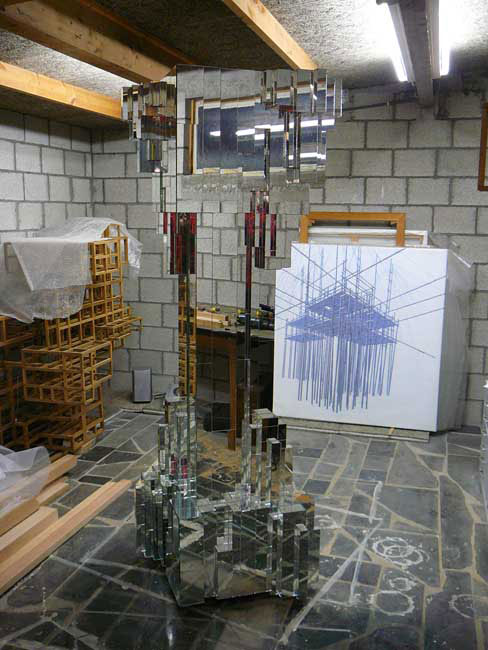
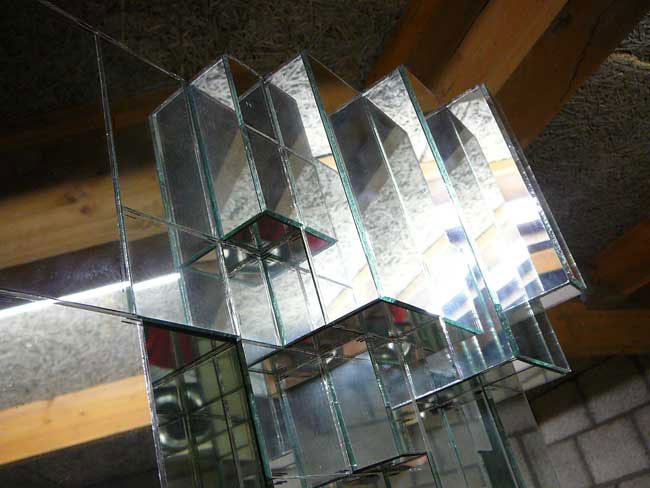
In Stilles Museum, Berlin, Juli 2002 - Geometrie aus hängendem Zedernholz
Künstler, die heute noch eine konstruktivistische Sprache benutzen um ihre Beziehung zur Welt auzudrücken, sind wirklich rar geworden. Noch immer scheint eine Art Tabu über den Gebrauch der Geometrie in der Kunst zu liegen. Obwohl es immer deutlicher wird, dass für eine Menge von Künstlern die Architektur mehr und mehr ein Mittel wird und bleibt, um die komplexe Welt etwas mehr durch ihre Hand zu ordnen. Ich denke z.B. an Manfred Pernice, Jan De Cock, Richard Venlet, Vaast Colson, Pieter Vermeersch u.v.a., die die Referenz an die Architektur als ein Mittel sehen, um ihre/ die Sicht auf und das Verhalten der Menschen in der Welt auszudrücken. In der Malerei bleibt die Geometrie meist auf die Verwendung von Rastern beschränkt als das Motiv der Moderne, Referenzen an die sichtbare Welt sind abwesend aber gleichzeitig kommen alle Prinzipien von Ordnung wie Linien zusammen. In der Rezeption der Malerei ist in diesem Zusammenhang vor allem das Werk von Günther Förg von Bedeutung.
In Belgien ist konstruktive Kunst ein Synonym für bildende Langeweile, da es den meisten Künstlern nicht gelingt, die Geometrie von dem durchsichtigem System der Komposition zu trennen. Damit rückt diese geometrisch inspirierte Kunst in die Nähe von Design, das nicht mehr ist, als ein primäres Spiel von Farbe, Linie und Fläche. Was kann man dann zu den frühen Arbeiten des amerikanischen Künstlers Frank Stella sagen? Dieses Werk ist ein wesentliches Projekt.
Die metallischen Bahnen in den Werken Stellas folgen den unregelmäßigen Konturen der Bildträger seiner Malerei und sie künden so auf eine tastbare Art und Weise darüber, dass Malerei nichts anderes darstellt als ihre Substanz und ihr Trägermaterial. Schon davor hatte der italienische Künstler Lucio Fontana die Illusion des Bildes als immatterielles Objekt durch einen Schnitt in die Leinwand zerstört.
1997 erwarb die Flämische Gemeinschaft für ihr zentrales Verwaltungsgebäude Ferraries in Brüssel Werke Breugelmans. Dort hängen Bilder mit äußerst komplexen "dichten" konstruktivistischen Motiven, die einen an das Skelett eines Gebäudes im Aufbau denken lassen. Die kreideblaue bis lichtgraue Farbgebung von diesen faszinierenden Bildern bezeichnet die Atmosphäre eines Architekturplanes, von etwas, das noch gebaut werden muß.
Es ist gut zu wissen, das Karel Breugelmans als Künstler auch noch einen Job im Bausektor hat. Dadurch weiß er ziemlich genau, was es heute bedeutet, ein Großprojekt zu realisieren. Seine Malereien wahren die Balance zwischen Figuration und Abstraktion. Das komplexe fast wissenschaftliche Linienspiel verweist nicht auf ein spezifisches Gebäude aber auf eine Art abstrakte Entwurfsidee für ein zukünftiges großes Gebäude.
Karel Breugelmans baut auch frei hängende Skulpturen aus Zedernholz. Diese schweben auf Augenhöhe im Raum. Man kann hinein und hindurchsehen, dadurch enstehen fortwährend verschiedene Perspektiven. Man kann sie auch als Köpfe betrachten, vergleichbar den früheren Betonraumskulpturen von Isa Genzken. Karel Breugelmans bringt die Architektur zurück zu ihrer essentiellen Urform, nämlich ein miteinander verknüpftes Lattengerüst aus Zedernholz, daß nur durch Holzspunte zusammengehalten wird.
Betritt man den Raum mit den Skulpturen, hat man das Gefühl, in eine futuristische Stadt zu blicken – eine Blaupause einer Stadt der Zukunft. Und doch ist diese Serie viel mehr, als ein geometrisch ausgeführtes Schlüsselwerk. Die pseudowissenschaftliche Aura dieser Architektur "Mobiles" enthält im großen Maße ihre poetische Wirkungskraft – die Geradlinigkeit der Skulpturen wird durch ihre kindliche Machart unterlaufen.
Und die unmenschliche Leere, die hier in den Mobiles inszeniert wird, setzt eine Reflexion über die zunehmende Entfremdung in Gang. Der Architektur von heute gelingt es nicht, der "res publica" – auch nur in einem Moment – eine Form zu geben und sie wieder aufleben zu lassen. Die Welt aus Beton und Stahl ist die Berufswelt des Künstlers Karel Breugelmans und mit einem äußerst feinsinnigen Gefühl für Ordnung und Harmonie weiß er in dieser Ausstellung ein beklemmendes Gefühl aufzuwecken.
Zedernholz bekommt nach einiger Zeit eine graue Färbung; im Garten der Galerie hängt eine seiner Strukturen in einem Baum – es ist ein schöne Kombination, die die Natur einbezieht, in ein Spiel langsam grauer werdender Ordnung und Gleichgewicht. Nicht für umsonst zitiert der Künstler in einem begleitenden Text Constantin Brancusi, der in seiner Bildhauerei eine endlose Schönheit erreichte.
"Das Schöne ist das absolute Gleichgewicht."
Luk Lambrecht
aus: De Morgen, 17.Mai 2002, Brüssel
Press Release - Ruimte Strukturen
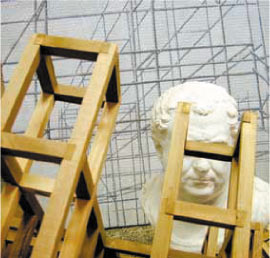 Ruimte strukturen Transit brengt nieuw werk van de Kempense kunstenaar Karel Breugelmans (°1955).
Ruimte strukturen Transit brengt nieuw werk van de Kempense kunstenaar Karel Breugelmans (°1955).
De Vlaamse Gemeenschap in Brussel verwierf in 1997 werk van hem voor de Ferraris-gebouwen. In 1998 nam Transit zijn werk op in de groepstentoonstelling 'bLIND dATE'. Nu volgt zijn eerste solotentoonstelling in Transit. Karel Breugelmans maakte tot 2001 enkel schilderijen en tekeningen. In Netwerk, Aalst, toonde hij voor de eerste keer enkele skulpturen.
In Transit brengt de kunstenaar nu tien nieuwe werken samen. Ze zijn allemaal gemaakt uit cederhout, ze hangen vrij in de ruimte op ooghoogte en nodigen uit om er tussen te wandelen en er mee te commmuniceren.
Breugelmans zoekt naar oerelementen en vormen. Ze versmelten en verwijderen zich in analogie met het wetenschappelijk zoeken naar de basiselementen van de materie. Tegelijk wil de kunstenaar in de opbouw van elk werk referen naar spanningen in de maatschappij en in elk individu.
De tentoonstelling opent op zondag 28 april van 14 tot 18 uur en loopt tot 23 juni 2002. De galerie is open elke zondag van 14 tot 18 uur, of na afspraak.
Meer informatie en een biografie van de kunstenaar op www.transit.be.
Foto's (digitaal) worden op eenvoudige aanvraag gemaild.
In 'De Morgen' van vrijdag 17 mei 2002 verscheen een duidend artikel van Luk Lambrecht onder de titel 'Geometrie van hangend cederhout'.
Een kopie van dit artikel wordt u op aanvraag toegestuurd.
Greet Paulissen in jaarboek Netwerk, Aalst
download hier het artikel als pdf [353 k]


